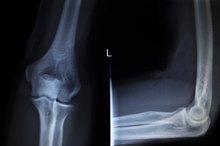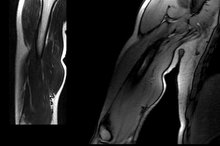Recovery Times for Serratus Anterior Rowing Injuries
The serratus anterior muscle covers the outer and posterior portions of the rib cage. It attaches to the upper ribs as well as to the shoulder blades. This muscle is an important stabilizer of the shoulder blades, holding them firmly to the rib cage, and it also works to rotate the shoulder blades upward and move the arms away from the body. This muscle is particularly prone to weakness.
Function of the Serratus Anterior in Rowing
In rowing, the serratus anterior has two main functions. During the drive phase -- when the rower pulls the oars through the water -- the serratus anterior contracts eccentrically to control the movement of the shoulder blades toward the spine. During the recovery phase -- when the rower moves the oars above the surface of the water -- the serratus anterior pulls the shoulder blades forward as the arms extend.
Injuries
What Are the Symptoms of Torn Tendons?
Learn More
The serratus anterior is susceptible to overuse injuries in rowing because of the high degree of repetitive motion. In overuse injuries, a muscle is subjected to numerous microtraumas at a rate that overwhelms the muscle’s ability to heal itself. With the serratus anterior muscle, overuse injuries can lead to stress fractures of the ribs.
Treatment
The treatment for serratus anterior injuries varies according to the severity of the injury. In general, health care practitioners recommend stopping or significantly reducing the activity that caused the injury. Once the acute pain has diminished, movement and strengthening of the muscles are encouraged. Consult your health care provider if you have questions about your recommended treatment.
- The treatment for serratus anterior injuries varies according to the severity of the injury.
Recovery Times
Torn Tendons & Ligaments From Hyperextension
Learn More
The recovery time depends on the nature and severity of the injury to the serratus anterior. In an overuse injury, the affected area becomes inflamed. This inflammation can last 48 hours to six days, if the area isn’t reinjured. If you continue to aggravate the injury, the inflammation phase will last longer. After the inflammation phase, the body enters the proliferative phase, during which it produces collagen and other substances necessary to repair the injured muscle. This phase typically lasts one or two weeks. However, if you irritate the muscle further, your body has to start over with the inflammation phase. The final stage of healing begins about three weeks after the initial injury. During this phase, the muscle rebuilds itself. Before returning to your previous activity level, you must strengthen the serratus anterior muscle. Gradually build up strength to avoid damaging the muscle again.
- The recovery time depends on the nature and severity of the injury to the serratus anterior.
- If you continue to aggravate the injury, the inflammation phase will last longer.
Related Articles
References
- Stress Fractures: Peter Brukner et al.
- Nerve and Vascular Injuries in Sports Medicine: Venu Akuthota and Stanley A. Herring
- Musculoskeletal Interventions: Techniques for Therapeutic Exercise: Michael L. Voight et al.
- 100 Questions and Answers About Your Sports Injury: Thomas M. Howard et al.
- Women’s Sports Medicine and Rehabilitation: Nadya Sedan
- Bull’s Handbook of Sports Injuries: R. Charles Bull and William O. Roberts
- Carr JB, John QE, Rajadhyaksha E, Carson EW, Turney KL. Traumatic avulsion of the serratus anterior muscle in a collegiate rower: a case report. Sports Health. 2017;9(1):80-83. doi:10.1177/1941738116670636
- Gooding BW, Geoghegan JM, Wallace WA, Manning PA. Scapular winging. Shoulder Elbow. 2014;6(1):4-11. doi:10.1111/sae.12033
- Lee SY, Lee HD, Cho YS, Han SH. Winged scapula caused by dorsal scapular neuropathy combined with suprascapular neuropathy: a case report. Medicine (Baltimore). 2018;97(40):e12515. doi:10.1097/MD.0000000000012515
- Mastrella Ade S, Freitas-junior R, Paulinelli RR, Soares LR. Incidence and risk factors for winged scapula after surgical treatment for breast cancer. J Clin Nurs. 2014;23(17-18):2525-31. doi:10.1111/jocn.12443
- Feinberg JH, Radecki J. Parsonage-turner syndrome. HSS J. 2010;6(2):199-205. doi:10.1007/s11420-010-9176-x
- Day J. Effect of Exercise Position on Percent Changes in Serratus Anterior Muscle Thickness. J Exerc Sports Orthop. 2017 Jan; 4(1): 1-6. doi:10.15226/2374-6904/4/1/00153
Writer Bio
Kat Black is a professional writer currently completing her doctorate in musicology/ She has won several prestigious awards for her research, and has had extensive training in classical music and dance.









